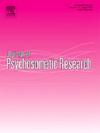Self-management and treatment adherence in pediatric irritable bowel syndrome (IBS): A longitudinal study
IF 3.3
2区 医学
Q2 PSYCHIATRY
引用次数: 0
Abstract
Background
Despite the increasing prevalence of pediatric irritable bowel syndrome (IBS), multifaceted treatment, and stomach pain being one of the most common reasons youth see the doctor, there is a dearth of literature concerning self-management in this population.
Objectives
This pilot study addresses this by providing a characterization of these variables and associated factors via a microlongitudinal and longitudinal design.
Methods
Daily diary data from 50 youth (10–18 years old) diagnosed with IBS across three 7-day time points were analyzed via multi-level modeling. This study took place during the COVID-19 pandemic.
Results
Most youth reported pain being a five out of ten and subjective well-being between five and eight. Oral medication/supplements were the most commonly reported treatment prescribed. However, the highest adherence was among those prescribed physical therapy. Youth were most likely to report their adherence strategy being/including caregiver reminders, and use of distraction as a coping skill to deal with their IBS pain. There was a significant inverted relationship between youth who reported caregivers reminded them to do treatment and/or they used a phone app with their report of well-being (β = −1.56, β = −2.29). Youth who reported greater confidence in their ability to problem-solve symptoms had significantly higher rates of physical activity (β = 0.06).
Conclusions
Self-management is important for youth experiencing chronic pain/IBS. Given the integrated treatment approach, common age of diagnosis, and intermittent symptom activity, identifying barriers and facilitators is critical to help tailor treatment and improve health outcomes. Future studies with larger samples should focus on further identification of modifiable variables to inform targeted interventions.
儿童肠易激综合征(IBS)的自我管理和治疗依从性:一项纵向研究
背景:尽管儿童肠易激综合征(IBS)的患病率越来越高,多方面的治疗和胃痛是年轻人就医的最常见原因之一,但关于这一人群自我管理的文献却很少。本初步研究通过微纵向和纵向设计提供这些变量和相关因素的特征来解决这个问题。方法对50名确诊为肠易激综合征(IBS)的青少年(10-18岁)3个7天时间点的日常日记数据进行多层次建模分析。这项研究是在COVID-19大流行期间进行的。结果大多数年轻人报告疼痛为5分(满分10分),主观幸福感在5到8分之间。口服药物/补充剂是最常见的治疗处方。然而,最高的依从性是那些规定的物理治疗。年轻人最有可能报告他们的坚持策略是/包括照顾者提醒,并使用分散注意力作为应对IBS疼痛的应对技巧。报告看护人提醒他们做治疗和/或他们使用手机应用程序的青少年与他们的幸福感报告之间存在显著的反向关系(β = - 1.56, β = - 2.29)。那些对自己解决问题的能力更有信心的青少年有更高的体育活动率(β = 0.06)。结论自我管理对慢性疼痛/肠易激综合征的青少年很重要。考虑到综合治疗方法、常见的诊断年龄和间歇性症状活动,确定障碍和促进因素对于帮助定制治疗和改善健康结果至关重要。未来更大样本的研究应侧重于进一步确定可修改的变量,以告知有针对性的干预措施。
本文章由计算机程序翻译,如有差异,请以英文原文为准。
求助全文
约1分钟内获得全文
求助全文
来源期刊
CiteScore
7.40
自引率
6.40%
发文量
314
审稿时长
6.2 weeks
期刊介绍:
The Journal of Psychosomatic Research is a multidisciplinary research journal covering all aspects of the relationships between psychology and medicine. The scope is broad and ranges from basic human biological and psychological research to evaluations of treatment and services. Papers will normally be concerned with illness or patients rather than studies of healthy populations. Studies concerning special populations, such as the elderly and children and adolescents, are welcome. In addition to peer-reviewed original papers, the journal publishes editorials, reviews, and other papers related to the journal''s aims.

 求助内容:
求助内容: 应助结果提醒方式:
应助结果提醒方式:


